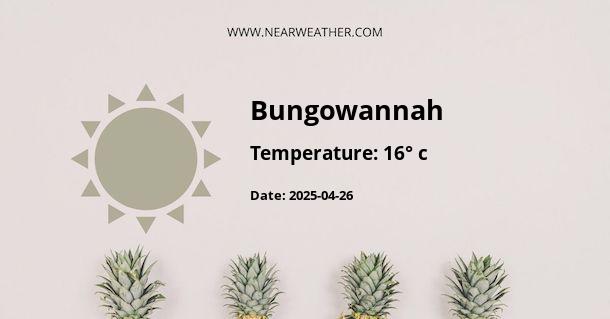Climate and Weather in Bungowannah, Australia
Bungowannah is a small rural locality located in New South Wales, Australia. Situated in the Riverina region, Bungowannah experiences a unique climate characterized by distinct seasons and a relatively moderate weather throughout the year. Let's delve into the detailed climate and weather patterns that define Bungowannah.
Temperature
The temperature in Bungowannah varies significantly across the seasons. Summers are generally hot and can reach temperatures above 30 degrees Celsius (86 degrees Fahrenheit). On the other hand, winters are relatively mild and can see temperatures drop to around 5 degrees Celsius (41 degrees Fahrenheit). Spring and autumn offer a pleasant transition with temperatures ranging between 10 and 25 degrees Celsius (50 to 77 degrees Fahrenheit).
To get a better understanding of the temperature patterns in Bungowannah, let's take a look at the average monthly temperatures throughout the year:
| Month | Average High (°C) | Average Low (°C) |
|---|---|---|
| January | 30 | 16 |
| February | 29 | 16 |
| March | 26 | 13 |
| April | 22 | 9 |
| May | 18 | 6 |
| June | 14 | 4 |
| July | 13 | 3 |
| August | 15 | 4 |
| September | 19 | 7 |
| October | 22 | 10 |
| November | 26 | 12 |
| December | 29 | 15 |
As illustrated in the table, the hottest months of the year are January and February, with average high temperatures of 30 and 29 degrees Celsius (86 and 84 degrees Fahrenheit) respectively. The coolest months are June and July, with average high temperatures of 14 and 13 degrees Celsius (57 and 55 degrees Fahrenheit) respectively.
Rainfall
Bungowannah experiences a moderate amount of rainfall throughout the year. The wettest months are typically in spring and early summer, while the driest months are in late summer and autumn. The annual rainfall in Bungowannah averages around 600 millimeters (23.6 inches).
Let's take a closer look at the average monthly rainfall in Bungowannah:
| Month | Average Rainfall (mm) |
|---|---|
| January | 36 |
| February | 36 |
| March | 29 |
| April | 36 |
| May | 42 |
| June | 38 |
| July | 39 |
| August | 39 |
| September | 38 |
| October | 53 |
| November | 44 |
| December | 32 |
From the table above, we can observe that October tends to be the wettest month in Bungowannah with an average rainfall of 53 millimeters (2.1 inches). The driest months are typically January, February, and December with average rainfall ranging between 32 and 36 millimeters (1.3 to 1.4 inches).
Sunshine Hours
Bungowannah enjoys ample sunshine throughout the year. On average, Bungowannah experiences around 2,700 hours of sunshine annually, which is equivalent to approximately 7.4 hours of sunshine per day. This makes it an ideal place for outdoor activities and agricultural pursuits.
Wind Patterns
The wind patterns in Bungowannah are influenced by its geographical location and the surrounding landscape. The prevailing winds in the area come from the west and southwest. These winds are generally gentle to moderate, providing a pleasant atmosphere for the residents and visitors.
Conclusion
Bungowannah, Australia, experiences a moderate climate with distinct seasons. Summers are hot, while winters are mild. The area receives a moderate amount of rainfall throughout the year, with the wettest months being in spring and early summer. Bungowannah also enjoys ample sunshine, making it an attractive destination for outdoor activities. Overall, the climate in Bungowannah provides a comfortable and enjoyable environment for its residents and visitors alike.
A - Bungowannah's Latitude is -36.016670 & Longitude is 146.766663.
A - Weather in Bungowannah is 26° today.
A - Climate Conditions in Bungowannah shows broken clouds today.
A - Humidity in Bungowannah is 41% today.
A - Wind speed in Bungowannah is 1.58 km/h, flowing at 128° wind direction. today.
